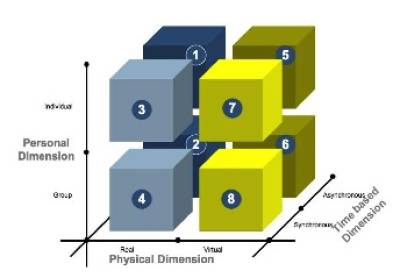Sidebar
Dimension of the different project phases
| Problem | Depending on the learning aims, different dimensions (individual learning vs. group learning, physical vs. virtual space, synchronous vs. Asynchronous communication) are required in different phases of the VCL project. |
|---|---|
| Framework | solving a case study in virtual environment; international, distributed teams; work in small groups; group processes are a part of the assessment; necessity for transparent communication of the participants |
| Solution | The three dimensions (personal, physical, and time-based dimension) result in eight combinations:  The nature of the VCL project, however, further limits the possible combinations. -Physical dimension The choice of the learning space (virtual vs. physical) is limited by the location of the participants. If teams consist of (internationally) distributed members, then the use of physical learning space (such as a particular classroom) is practically impossible. If groups include more than one member from the same institution, these are free to meet face-to-face, but they will still have to further communicate and coordinate the results of the face-to-face meeting with the other team members using the virtual space. -Time-based dimension Deciding between synchronous and asynchronous communication depends on a particular situation and is determined by factors such as target audience, content, and nature of the communication. Participants, tutors, and instructors are free to decide whether they wish to use asynchronous communication (e.g. forum, e-mail, pin wall) or synchronous communication (VoIP, chat, phone call, face-to-face). Because the choice is often personal (some teams work better with asynchronous other with synchronous communication), the participants should be provided with infrastructure for both communication means. As there are many communication platforms and tools available, it is easy for participants to pick and choose; however, this might lead to direct communication outside the central platforms that could be undesirable (e.g. for the assessment). Providing communication tools and usage rules should thus be considered carefully beforehand. Support should be provided for participants who are not familiar with the tools. -Personal dimension The nature of VCL projects is to facilitate collaboration, placing learning in a group into focus. Depending on the aims, it would be possible to integrate preparatory phases requiring the participants to fulfil individual tasks. Ultimately, however, it is the group learning that is the main learning experience in a VCL project. The dimensions, though limited by the concept of a VCL, still leave some room for the organisers to adapt them to their own needs and learning aims. This could include a preparatory face-to-face phase in a classroom carried out at each partner location or individual learning phases with tasks for each participant independent of a group. Similarly, the groups can be given the opportunity to determine some of the dimensions themselves, such as choosing communication forms, having local meetings of some team members or even assigning individual sub-tasks. The most open dimension is the time-based dimension, allowing the choice between synchronous and asynchronous communication media. This is a key dimension as it can be handled fairly flexibly but can also influence the learning experience. It should be noted that placing limitations on the choice of communication will influence the communication processes within the group and should thus be done with care. The choice of communication includes two points: communication form and space/tool. Prescribing the communication form can strongly effect the groups and should be done with caution and only if there are sound reasons (such as training purpose). The choice of a suitable tool can be either left to the group or prescribed. If work with different communication tools is a part of the learning aims (e.g. getting to know Social Media), then the groups should be left to choose for themselves. If the learning aims are independent of the used tools, the tools can be prescribed for greater efficiency, as the groups then do not have to lose time choosing tools. It should be taken into account when planning the VCL project, that the work in a virtual environment in groups will negatively affect the efficiency of communication, i.e. participants will find that they need to invest more time into the virtual communication than they are used to expect of face-to-face group work. This effect should also be communicated. |
| References | Internationality/geographic distribution of teams Introduction of the Participants to the Tools / ICT Content of the Role Description Learning objectives of the VCL project Time management |
Page Tools
Except where otherwise noted, content on this wiki is licensed under the following license: CC Attribution-Noncommercial 4.0 International
